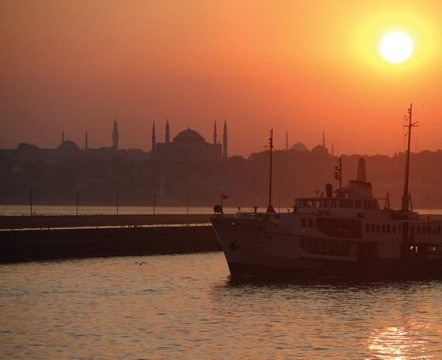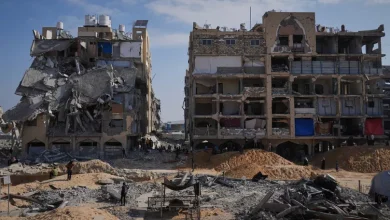
Seth Kugel, a member of New York Times News Service, explored the City at Bosphorus, aiming to spend a weekend in a metropolis such as Istanbul with a budget of $100.
I usually love to be where the action is, but there are exceptions. “Waiting for a ferry to the Greek Islands just as port workers go on strike” is right up there with “staying in a youth hostel that is hosting the World Snorers Convention.”
The port strike was why I ditched Greece and hopped right from Albania to Istanbul on my Frugal summer tour of the Mediterranean. By hopped, I mean spent 48 hours on, and waiting for, buses, just barely making it to Istanbul in time for one of my favorite activities: the $100 weekend.
Yes, the $100 weekend, during which, through sleight of hand, I amaze the world by having a great time in a major city for a preposterously small amount of money.
After doing this in New York, Paris and Rio de Janeiro, I have to come clean: I’m just an illusionist. Cosmopolitan metropolises are not the hardest places to live cheaply for a weekend; in fact, they can be the easiest.
Istanbul, like those other cities, is theoretically an expensive place, where a single meal, or even taxis to and from the airport, can run you $100.
But all these cities have cheap food galore and free culture that’s yours for the Googling; they are also blanketed by public transportation and unpredictable enough to make delightful surprises almost inevitable.
How to do the $100 weekend in Istanbul?
How do you kill two hours in Istanbul without spending a dime? Accidentally discover a Senegalese music festival right in the heart of Sultanahmet, with the Blue Mosque as a backdrop.
The $100 budget doesn’t account for housing, but I try to stay in the spirit by finding a place to crash for free.
This time, I used CouchSurfing, the site on which members post detailed profiles and ask other members for a couch or extra bed or floor to crash on.
But it’s not as simple as it seems. The more detailed your profile, the more witty or engaging your plea for a couch, and the more times you’ve hosted people and been hosted, the easier it is. This was my first time, so I was rejected repeatedly, until I got the idea to search for other newbies.
It worked, and I got the thumbs up from Erol Fazlioglu, a self-employed engineer who was tickled that we had both memorized the world’s capitals when we were kids, something I had put in my profile. He offered an air mattress in a spare bedroom in his apartment in Kadikoy, on the Asian side of the city.
Istanbul is often referred to as the city where East meets West, and it’s no metaphor: The city is split by the Bosporus Strait into a European side, where most tourist attractions are and most travelers stay, and the more residential (but hardly sleepy) Asian side. The sides are connected by two bridges and numerous ferries.
Erol and I ended up spending most of the weekend together. We tested each other on capitals, of course, but mostly I asked him to decode the city’s mysterious mix of Muslim and secular life.
Erol (an agnostic from a Muslim family) liked to spice up his answers by belting out “Tradition” in his best Tevye from “Fiddler on the Roof” voice.
(A disclosure: Erol discovered online that I was a travel writer. Perhaps I’m being naive, but I think he would have treated me the same even if I weren’t, for three reasons: We really hit it off, he was naturally hospitable, and he had no plans for the weekend.)
Friday
With only $100, or 160 Turkish lira, to spend from Friday afternoon to Sunday afternoon, the first order of business was to load credit onto an Akbil, the public transportation pass that looks like an ice cream tasting spoon with a metal disk on the end and works smoothly across Istanbul’s ferry, bus, tram and subway systems.
After crossing to the European side on one of the frequent ferries (1.65 lira, or $1), our first stop was in the formerly rough Tophane neighborhood, where an arts scene has recently developed.
Galleries are frugal travelers’ museums: Not only are they nearly always free and nearly never musty, but they also provide insight into the local arts scene that would otherwise require a lot of trendy-cafe eavesdropping. (Not to mention learning Turkish.)
At our first stop, Depo, two films by the Norwegian artist Knut Asdam were being featured. Our second stop, Non, was my favorite, less for the exhibits than for the minimalist staircases, which hang from the ceiling with suspension-bridge-like cables. Cool. Next was Daire, where the Turkish artist Ceylan Ozturk has created striking works out of single words or phrases. Erol was smitten.
“When I visit this kind of place, I feel sorry for not being an artist,” he said.
So far, so free. We had to eat, naturally, and my major plan for the evening was to tick the famed Gulluoglu baklava palace off my list. I’m not beyond simply gorging on sweets for dinner, but to create the illusion of normality we stopped for a 2 lira ($1.25) lahmacun, a minced-meat pizza.
Then it was time for the sweet, sticky pastry with walnuts or pistachios that Gulluoglu had in countless varieties, each one more delicious looking than the next. I have no idea whether this place has the best baklava in Istanbul, but I’d be happy to die trying to find out. With tea, it cost us 5.50 lira ($3) each.
From there, it was off to Istanbul’s see-and-be-seen stroll-and-drink district, centered on Istiklal Street. A friend had told me where I could find the best Turkish coffee (walk to the Barcelona Cafe and turn down the alley), but she didn’t know the name of the place. When Erol heard the instructions, he knew: Mandabatmaz.
There, Cemil Pilik, a graying, slightly stooped man with a prominent nose and a far less prominent hairline, spoons the fine grounds of Turkish coffee into a little pot with the requested amount of sugar (az means lightly sweetened), and works his magic over a blue flame. Seating is in the alley. Coffee is 3 lira ($1.90).
Istanbul has to offer much in various price ranges..
Next, we went to nearby Nevizade Street, so packed with bars that for me to choose one would have been an exercise in randomness. But Erol had a favorite, so we shoehorned ourselves into a sidewalk table at Kameriye, where we were so mesmerized by the scene that what should have been one 7-lira ($4.40) beer turned into two and then three. After a late bite and a 6.50 lira ($4) shared van back across to Kadikoy, I had spent 60.95 lira, or $38.
Saturday
It didn’t occur to me until Saturday — tourist attraction day — that there might have been some advantages to having a practicing Muslim, instead of the agnostic Erol, as my host. For example, Erol and I arrived at the famed Blue Mosque and found it just closing for prayer. We came back later in the afternoon, just in time for the next prayer, and ended up dilly-dallying for 45 minutes waiting for it to end. Come on, Erol, keep track of these things. (Note to readers: Prayer times are easily found online.)
We filled the intermediate time in part with a trip to the Grand Bazaar. Jammed with endless streets lined with jewelry, rug and souvenir shops, the bazaar didn’t really do it for me.
“Except for the ancient roof,” I told Erol, “this doesn’t look like a bazaar. It looks like a mall.”
“They didn’t have malls in the 15th century,” he replied.
Touche. Still, it’s the same idea, and being in a mall with no money to spend is no fun.
The afternoon quickly became better when we met up with Ansel Mullins, a creator of the locally famous Istanbul Eats blog who had offered to introduce me to an area of town where restaurants specialized in dishes from the province of Sanliurfa, near the Syrian border.
He then stuffed me to within a crumb of my life on a three-course, three-restaurant crawl, all on the same square block. We had a spicy sheep’s neck soup called beyran at Ehli Kebap; a lahmacun (that minced-meat pizza) served with fresh parsley leaves at Beyzade; and moist lamb kebabs, one with eggplant and one with pistachios, at Urfali Haci Usta. My share was 28 lira ($17.50), and I ate enough for two. Two elephants.
Our last stop on the European side was unplanned. We ran smack into a Senegalese festival at the Sultanahmet Amphitheater, a rocking event that reminded me of Summerstage in New York.
A boisterous and talented Senegalese singer introduced as Salaam had what seemed to be a local population of West African immigrants going bonkers for music from home, and the local audience somewhat haplessly trying to get into the rhythm and spirit.
Then it was back to the Asian side for a relaxing — and very cheap — evening: coffee at an outdoor cafe on the water, a cone from the beloved Ali Usta ice cream shop, and a drink (a 10-lira, or $6.25, double-dose of anise-flavored raki) at the cozy back garden of the Lal bar on Kadife, a street of fashionable watering holes in the Moda section of Kadikoy.
Total spent through Saturday night: 125.35 lira, or $77.93.
Sunday
I had saved Sunday for a museum day, but my plans changed when, the night before, I discovered online that Turkish baths, out of my reach on the touristy European side, were actually affordable if I stayed on the Asian side.
Museums exist everywhere, but here was a chance to do a Turkish bath in Turkey. So Erol and I headed to Carsi Hamami, a neighborhood bathhouse right near the ferry stop on the Asian side. The entrance fee is 15 lira ($9.40), and it’s 5 lira each for the scrub (which removes all that dead skin) and massage (which was mediocre, but for $3, who’s complaining?).
I walked out with 1 lira to spare and realized that I had yet to try a simit, the sesame-crusted ring-shaped bread that is ubiquitous and dirt cheap across the city. (You could do a $10 weekend if you lived on it exclusively.)
With my final coins, I bought two. Erol and I went home, melted cheese on them and quite literally toasted our accomplishments as we continued to pepper each other with world capital trivia.
Total spent: 160.10 lira, or $99.54.
By Seth Kugel / New York Times News Service
[adrotate group=”9″] [adrotate banner=”33″]
Istanbul, Istanbul Turkey, Turkey, Istanbul Nightlife, Istanbul Bosphorus, Istanbul Tourist, Istanbul Asia Europe


